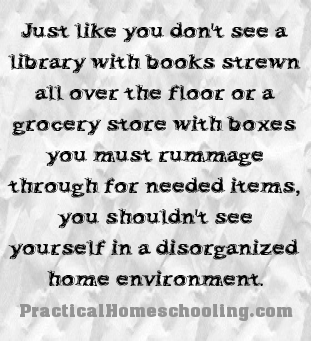Getting Organized Part 2
By Kathy von Duyke
Printed in Practical Homeschooling #13, 1996.
 Just like you don't see a library with books strewn all over the floor or a grocery store with boxes you must rummage through for needed items, you shouldn't see yourself in a disorganized home environment.
Just like you don't see a library with books strewn all over the floor or a grocery store with boxes you must rummage through for needed items, you shouldn't see yourself in a disorganized home environment.

|
 |
 Last issue I shared with you my Six Steps to Homeschool Sanity. As you may recall, they were:
Last issue I shared with you my Six Steps to Homeschool Sanity. As you may recall, they were:
- Organize around themes
- Less is more
- Plan in blocks
- Prioritize space by time, money, and use
- Put it in plastic
- Weed consistently
We talked about the first four steps in the first article. Now, I'm going to show you how to Store for Success!
Playing Store
When was the last time you went to the library and noticed all the books on the floor? When did you hit the grocery store and have to rummage through piles of boxes? I know storage containers are expensive, but by prioritizing your storage you know where to rely on homemade containers and where to invest your money.
I remember baby-sitting for a friend who had a very nice play area, with all the toys categorized and shelved in homemade containers. Unfortunately, the shelf and the containers were poorly made. When her little boy scrambled up to get an item, the whole system came tumbling down. We were looking at several hours of sorting!
My friend's carefully selected categories helped her child play in a purposeful way, unlike a child who is distracted from deep play by the mess (usually created when the toy box gets dumped to find that one special toy). However, her system wasn't up to the hard use under which it was required to perform. As a result, she bought sturdier shelving and clear containers with lids that snapped on securely. She hadn't felt she could afford the containers until she saw the valuable time it was costing her to not have them.
My favorite organizers are Velcro, clear slip-in report covers, and large plastic containers with lids. Here's how I use each:
Velcro
This sticky-backed tape comes in three decorator colors: white, beige, and black. I keep some strips on the wall space designated for posters. The wall gets the fuzzy side, and the poster, which I laminate, gets the looped side. This makes it easy to rotate posters or maps according to our needs, without leaving lots of holes in the walls. Unfortunately, you can't take the Velcro off without removing the paint, so I use the color that best blends in. I also use Velcro on the back of a clipboard to attach notes to my work station. A piece of Velcro keeps the VCR remote stuck to the monitor, and pencils stuck to pads near the phone. Velcro is also wonderful on felt. I stick it on little timeline people to fit them on a large piece of felt. The figures come off, but don't constantly fall. In humid climates, where basement walls spit off tape like a baby spits spinach, posters stuck on with Velcro will stay.
Slip-in Report Covers
I originally began using these pocketed report covers to make up my children's school portfolios, and they work great. The younger children enjoy browsing through their older siblings' work, and we have no fear of damage. The artwork can also be beautifully displayed. One reader told me that she had used this idea and built an art portfolio dating back to the time when her child was scribbling. She keeps it on the coffee table with other display art books. What a way to motivate a child!
Since we keep a large supply of these plastic sheets handy, we've found other ways to use them. I organize my sewing patterns with them. The illustration on the pattern envelope goes in front of each plastic pocket. Each size I design goes into its own cover. When I want to make PJ's or sweats for several children, I can readily find the sizes I need. I keep women's dress patterns in one binder so I can easily flip through to the pattern I want. In another binder, I have collected iron-on appliques with coordinating fabric in each pocket.
In the kitchen I use the covers to hold our favorite recipes. I told you about my themes; well, this works in cooking, too. Monday is Mexican night, Thursday is stir-fry night, Friday is always Dad's homemade pizza. Under my Monday tab I'll find several of our favorite Mexican dishes, plus whatever else I've planned to make that day of the week.
In my teaching binder, I keep my master chore sheets in one cover and our monthly timeline people in another. I've also been known to tape a report cover opposite the toilet and fill it with poetry or scripture we are attempting to memorize.
I generally buy report covers in bulk through Viking office supplies. They also carry Velcro and ship free to your door, usually by the next day.
Don't Put It Down, Put It Away
Once you've organized your materials, you need to teach yourself and your children to put things away. When a new area is established, I have difficulty getting in the habit of putting items in the right bins. My children may toss items anywhere. I will go through and rearrange misplaced items, until my children catch on. After a while, they know where things go and begin to put them there themselves.
When they neglect to follow through, I will remind them to "put the details away." If needed, I will ask a child to pull a whole section of drawers and put away each detail that they've allowed to pile up. I point out how much easier it is to maintain the system if they put things away directly after they use them.
I keep a little bin or basket for odds and ends that I pick up throughout the day, and designate one child to go find the homes for the items. This has helped keep us from losing scores of minuscule game pieces.
Believe it or not, the children really like to have things organized. They like to know where to get what they want, when they want it.
Next issue I'll conclude by sharing how plastic storage bins have made my life more organized - and simpler.